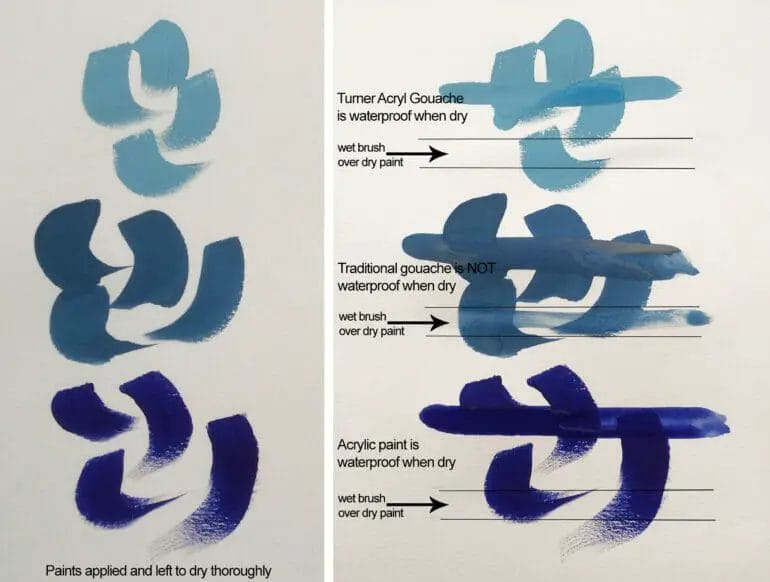Gouache paint and acrylic paint are both popular choices for artists, but they have distinct characteristics and uses. Gouache paint is a water-based medium that offers vibrant and opaque colors, making it ideal for detailed illustrations and vibrant artworks. On the other hand, acrylic paint is a versatile medium that dries quickly and has a flexible finish, allowing artists to create both transparent and opaque layers. While gouache paint can be reactivated with water even after drying, acrylic paint becomes water-resistant when dry. Ultimately, the choice between gouache and acrylic depends on the desired effects and techniques of the artist.

Choosing the Right Paint: Gouache or Acrylic?
When it comes to choosing the right paint for your artistic projects, there are several options available. Two popular choices among artists are gouache and acrylic paint. While both mediums offer their own unique qualities, understanding the differences between them can help you make an informed decision.
Gouache Paint
Gouache paint is a water-based medium that contains pigment, a binding agent, and a white, chalky substance called “gouache.” It is known for its vibrant colors and opaque finish. Gouache paints have been used by artists for centuries, dating back to the ancient Egyptian and medieval illuminated manuscript traditions.
Gouache paints are highly versatile and can be used for a variety of techniques. They can be diluted with water to create transparent washes or applied in thick layers for a more opaque effect. Gouache also has excellent coverage, allowing you to easily correct mistakes or make changes to your artwork.
One of the main advantages of gouache is its ability to dry quickly. This makes it a great choice for artists who prefer to work in layers or want to create detailed paintings. Gouache also has a matte finish, which can create a unique visual effect.
Acrylic Paint
Acrylic paint, on the other hand, is a water-based medium that contains pigment suspended in an acrylic polymer emulsion. It is known for its versatility, durability, and quick drying time. Acrylic paints were first introduced in the 1950s and quickly gained popularity among artists.
Acrylic paints have a wide range of colors and can be easily mixed to create an infinite palette. They can be used on various surfaces, including canvas, wood, and paper. Acrylics can be applied thinly like watercolors or built up in layers like oils. They also have a flexible and water-resistant finish, ensuring the longevity of your artwork.
One of the main advantages of acrylic paint is its fast drying time. This allows artists to work quickly and make changes to their artwork without having to wait for the paint to dry. Acrylics also have a glossy finish when dry, which can enhance the vibrancy and depth of your artwork.
Choosing the Right Paint for Your Project
When deciding between gouache and acrylic paint, consider the following factors:
- Opacity: If you prefer a more opaque finish, gouache may be the better choice. Acrylic paints can be more transparent depending on how they are applied.
- Drying Time: If you work in layers or require quick drying time, gouache is the ideal option. Acrylic paint dries faster than gouache.
- Surface: Consider the surface you will be painting on. Acrylic paint can be used on various surfaces, while gouache is best suited for paper or illustration board.
- Color Mixing: If color mixing is important to your artwork, acrylic paint offers a wider range of colors and allows for easy mixing.
- Longevity: Acrylic paint is more durable and long-lasting than gouache, making it a great choice for artworks that need to withstand the test of time.
In summary, both gouache and acrylic paint have their own unique qualities and advantages. Gouache is known for its opaque finish, fast drying time, and matte appearance, while acrylic paint offers versatility, durability, and a glossy finish. When choosing the right paint for your project, consider your preferences and requirements to make an informed decision.

Exploring the Unique Qualities of Gouache and Acrylic Paints
When it comes to painting, artists have a wide range of mediums to choose from. Two popular options are gouache and acrylic paints. Both have unique qualities that make them suitable for different artistic styles and techniques. In this section, we will explore the characteristics of gouache and acrylic paints, highlighting their similarities and differences.
Gouache Paint
Gouache paint is a type of watermedia that is known for its opaque and matte finish. It consists of pigment particles suspended in a binder and gum arabic, which gives it its water-soluble properties. Gouache paints are often used by illustrators and designers due to their vibrant colors and ability to create smooth and flat surfaces.
One of the main advantages of gouache paint is its opacity. The high concentration of pigments allows artists to achieve solid, opaque layers of color. This makes gouache ideal for creating vibrant and bold artworks, as well as for correcting mistakes or covering up previous layers. Additionally, gouache can be easily reactivated with water, allowing for blending and layering techniques.
Another unique quality of gouache paint is its ability to create a matte finish. Unlike other paints that dry to a glossy sheen, gouache dries to a flat, velvety surface. This makes it an excellent choice for artists who prefer a more subdued and muted effect in their paintings.
Acrylic Paint
Acrylic paint, on the other hand, is a versatile and widely used medium that consists of pigment suspended in an acrylic polymer emulsion. It is known for its fast-drying properties and ability to adhere to a variety of surfaces. Acrylic paints come in various viscosities, ranging from fluid to heavy body, allowing artists to experiment with different textures and techniques.
One of the main advantages of acrylic paint is its quick drying time. Unlike oil paints, which can take days or even weeks to fully dry, acrylics dry within minutes to hours, depending on the thickness of the paint and environmental conditions. This makes acrylics perfect for artists who prefer to work quickly or layer their paintings without waiting for extended drying times.
Furthermore, acrylic paints have excellent lightfastness and durability, ensuring that artworks created with acrylics will maintain their color and quality over time. Acrylics are also versatile in terms of surface compatibility, as they can be used on canvas, paper, wood, and even metal.
Similarities and Differences
- Both gouache and acrylic paints can be diluted with water for easier application and blending.
- Gouache is more opaque than acrylic paint, allowing for solid and vibrant colors, while acrylic paint can be transparent or opaque depending on the pigment load and application.
- Acrylic paint has a wider range of viscosities and can be used to create various textures, from thin washes to thick impasto.
- Gouache dries to a matte finish, while acrylic paint dries to a glossy or satin finish, depending on the formulation.
- Both paints can be used for layering and glazing techniques, although gouache may require additional fixatives to protect the layers.
In Summary
Gouache and acrylic paints offer artists unique qualities and possibilities in their artwork. Gouache is known for its opacity, vibrant colors, and matte finish, making it a popular choice for illustrators and designers. Acrylic paint, on the other hand, is versatile, quick-drying, and offers a range of textures and surface compatibility. Both paints have their strengths and can be used to achieve stunning effects in paintings. Whether you prefer the boldness of gouache or the versatility of acrylics, experimenting with different mediums can enhance your artistic journey and allow you to explore new artistic styles and techniques.

Pros and Cons of Gouache and Acrylic: Which is Better?
Gouache and acrylic are two popular mediums in the world of painting. Both offer unique benefits and drawbacks, making them suitable for different artistic needs. In this section, we will explore the pros and cons of gouache and acrylic to help you determine which medium is better suited for your creative endeavors.
Gouache
Gouache is a versatile medium that combines the characteristics of both watercolor and acrylic paint. Here are the pros and cons of using gouache:
Pros:
- Opacity: One of the major advantages of gouache is its high opacity. The pigments used in gouache are more opaque compared to watercolor, allowing artists to easily achieve vibrant and solid colors.
- Reactivatable: Gouache can be reactivated with water even after it has dried, making it a forgiving medium. This characteristic allows artists to make changes or blend colors even after the paint has dried on the surface.
- Matte Finish: Gouache dries to a matte finish, which can create a unique aesthetic in artworks.
- Easy to Work With: Gouache is generally easy to work with, especially for beginners. Its forgiving nature and fast drying time allow artists to experiment and make adjustments as they paint.
Cons:
- Color Shift: Gouache tends to dry to a slightly lighter shade than what appears when wet. This color shift can pose challenges when trying to achieve precise color matching.
- Less Durable: Gouache paintings may be more prone to cracking and peeling over time compared to acrylic paintings. This makes them less suitable for artworks that require long-term durability.
- Less Availability: Gouache is not as widely available as acrylic paint, making it a bit harder to find in art supply stores.
Acrylic
Acrylic is a popular medium known for its versatility and durability. Let’s explore the pros and cons of using acrylic paint:
Pros:
- Fast Drying: Acrylic paint dries quickly, allowing artists to layer colors and make adjustments without having to wait for extended periods.
- Longevity: Acrylic paintings are known for their durability. They are resistant to cracking, yellowing, and other forms of damage, making them suitable for long-term artworks.
- Variety of Textures: Acrylic paint can be applied in various ways to create different textures and effects, including thin washes, thick impasto, and everything in between.
- Wide Availability: Acrylic paint is widely available in art supply stores, making it easily accessible for artists.
Cons:
- Quick Drying: While the fast drying time can be an advantage, it can also be a disadvantage for some artists who prefer to blend and work with wet paint for longer periods.
- Less Forgiving: Once acrylic paint dries, it becomes permanent and cannot be reactivated with water. This characteristic makes it less forgiving for making mistakes or blending colors.
- Plastic Appearance: Acrylic paint dries to a glossy finish, which may not be preferred by artists who prefer a matte or textured look.
Which is Better: Gouache or Acrylic?
Choosing between gouache and acrylic ultimately depends on your artistic preferences and the specific project you are working on. If you prioritize opacity, reworkability, and a matte finish, gouache may be the better option. On the other hand, if you value fast drying time, durability, and a wide range of textures, acrylic paint may be more suitable.
In summary, both gouache and acrylic have their own pros and cons, and the choice between them should be based on your artistic goals and preferences. Experimenting with both mediums can also open up new possibilities and help you discover unique techniques and styles.
Tips for Working with Gouache and Acrylic Paints
Working with gouache and acrylic paints can be a rewarding experience for artists of all levels. These mediums offer versatility and vibrant colors, allowing artists to create stunning works of art. However, it’s important to understand the unique characteristics of each paint and follow certain tips to achieve the best results. In this section, we will explore some essential tips for working with gouache and acrylic paints.
1. Prepare your surface
Before starting your painting, it’s crucial to prepare the surface properly. For gouache, make sure to use a smooth and absorbent surface, such as watercolor paper or illustration board. Acrylic paints can be used on a variety of surfaces, including canvas, wood, and even glass. Ensure that the surface is clean, dry, and properly primed to ensure proper adhesion and longevity of your artwork.
2. Use the right brushes
Choosing the right brushes for your gouache and acrylic paintings is vital. For gouache, opt for brushes with soft bristles, such as synthetic or natural hair brushes. The soft bristles will help you achieve smooth and even coverage. Acrylic paints, on the other hand, require sturdier brushes with synthetic bristles, as acrylics can be more abrasive and cause wear on natural hair brushes. Consider investing in a variety of brush shapes and sizes to explore different textures and techniques.
3. Layering and building colors
Both gouache and acrylic paints allow for layering and building colors, but their techniques differ slightly. With gouache, you can achieve opaque, vibrant colors by layering multiple thin coats. Allow each layer to dry completely before applying the next to prevent muddying the colors. Acrylic paints, on the other hand, dry quickly, allowing you to layer colors more rapidly. Experiment with different layering techniques to add depth and dimension to your artwork.
4. Mixing and blending
When working with gouache and acrylic paints, mixing and blending colors is essential to achieve the desired shades and gradients. Use a palette or a mixing surface to blend colors together. Gouache paints can be easily reactivated with water, allowing you to create smooth transitions between colors. Acrylic paints can be mixed with water or acrylic medium to achieve different textures and effects. Take your time to experiment with color mixing and blending techniques to discover unique combinations.
5. Clean your brushes properly
Proper cleaning and maintenance of your brushes are crucial for their longevity and optimal performance. After each painting session, rinse your brushes in water to remove excess paint. For acrylic paints, use a mild soap or brush cleaner to remove any dried acrylic residue. Gouache paints can be easily washed off with water. Shape the bristles gently and allow the brushes to air dry completely before storing them.
6. Work in layers
Working in layers is a technique commonly used in gouache and acrylic paintings to add depth and detail. Start with a rough sketch or underpainting as a base layer. Then gradually build up the layers, allowing each layer to dry before adding the next. This technique allows you to refine your artwork with precision and control. Experiment with different layering techniques, such as glazing and scumbling, to achieve various effects and textures.
7. Protect your artwork
Once your gouache or acrylic painting is complete, it’s important to protect it to ensure its longevity. For gouache paintings, consider spraying a fixative or using a matte varnish to protect the surface from smudging or moisture. Acrylic paintings can be sealed with a varnish to protect them from UV light and dust. Properly framing your artwork with UV-resistant glass or plexiglass can also provide additional protection.
By following these tips, you can enhance your experience working with gouache and acrylic paints and create stunning artworks. Remember to experiment, have fun, and let your creativity flow!
FAQs
What is the difference between gouache paint and acrylic paint?
Gouache is a water-based paint that is opaque and dries to a matte finish, while acrylic paint is also water-based but dries to a glossy or satin finish. Gouache can be reactivated with water even after it has dried, while acrylic paint is permanent once it dries. Additionally, gouache is more suitable for fine details and layering, while acrylic paint is versatile and can be used on various surfaces.
Conclusion:
In conclusion, when comparing gouache paint and acrylic, it’s clear that each medium has its own unique characteristics and advantages. Gouache offers vibrant and opaque colors, making it ideal for detailed and precise artwork. On the other hand, acrylic paint provides versatility and durability, allowing for a wide range of techniques and applications. While gouache is often used for traditional and illustrative works, acrylic is favored in contemporary and abstract art. Ultimately, the choice between gouache and acrylic depends on the artist’s preferences, style, and desired effects. Both mediums offer endless creative possibilities, enabling artists to bring their visions to life.
